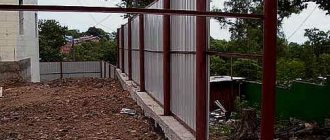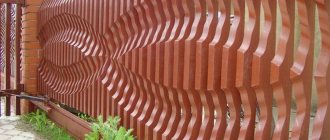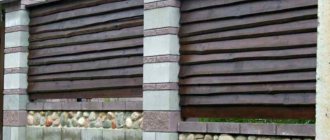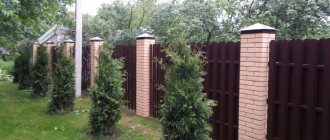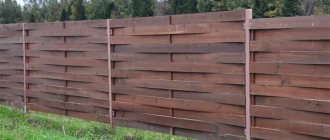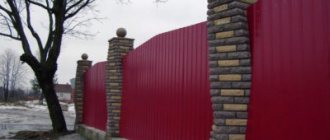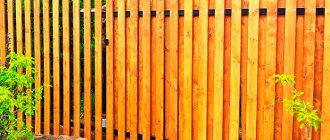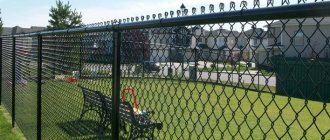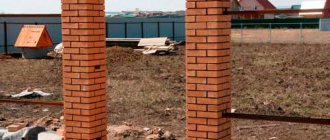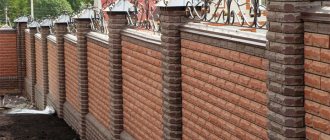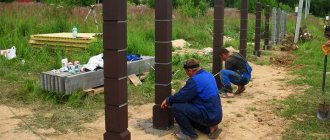When choosing fencing options for suburban real estate, owners often choose fences with brick posts. Ceramics are lighter than stone, and forged elements will add decorativeness to the design. With them, the fence takes on a noble appearance.
The combination of brick, metal and polycarbonate is a modern solution for fencing a suburban area
The combination of brick and metal - what is the advantage
Brick is a traditional building material that retains its strength for many years. There is no doubt about the effectiveness of using brick columns. The type of fencing generally determines the design of the spans.
The spans between brick pillars can be made of a variety of materials
The space between the supports is filled with:
- brickwork;
- boards;
- wall profiled sheet;
- gratings of various types.
Often combined structures are made: wickets, gates, sections nearby are made of lattice, the remaining spans are made of brick or wood.
Forged gates with polycarbonate on top and sheet steel inserts on the bottom
Spans made of corrugated sheets or brickwork between brick supports are not inferior in reliability, but inferior in decorativeness. Wood-brick structures are lightweight, do not require a powerful foundation, but are less practical. Wood requires regular treatment to increase moisture resistance and protection from fungal infections.
The advantages of brick-forged structures in comparison with other fencing options are obvious. They combine strength characteristics with aesthetic appearance. They create space for flights of fancy and manifestation of the owners’ individuality.
A brick fence with forging elements will emphasize the sophistication of the design of the surrounding area
Such a fence will organically fit into the overall style of landscape design
By combining metal and ceramics, they achieve good performance properties of fencing combined with high decorativeness. Artistic forging is a type of arts and crafts with a long history. A forged fence on brick pillars is an element of luxury and status for the owner of a country property. Such barriers easily withstand exposure to moisture and do not lose their aesthetics due to temperature changes or season changes. Such fences decorate the parks of world capitals.
Any version of a brick fence with forging is beautiful. These could be barriers:
- with brick spans, decorated with figured forged inserts;
- pointed decoration in the upper part or on top of the main structure, the metal serves as a decoration;
- gratings made of metal rods processed by forging and welding, characterized by good light transmission and not creating shadows for plants.
When forming brick columns, a cable for connecting lamps and embedded pins are laid inside, increasing the strength of the structures. Metal “ears” are brought out from the sides of the column, to which ready-made forged sections are mounted by welding.
It is necessary to think through the design of the pillars in advance
In order for the fence to last for a long time, it is important to choose the right materials and correctly draw up a design project.
What you need to know to order
In order for a brick fence with inserts made of forging elements to last as long as possible, it is important to observe the following nuances:
- correctly draw up technical specifications;
- select appropriate materials, including brick;
- perform installation in accordance with the requirements of the working documentation.
Brick used
The following types of bricks are used to construct a fence:
- Ceramic resists temperature, has strength parameters and a smooth surface.
- Fireclay is made from clay of the same name using firing technology. This brick has high performance parameters, including resistance to weathering. For installation you will need a special masonry mortar.
- Silicate is made from a cement-lime mixture using firing, which guarantees frost resistance and long service life. Sand-lime brick is inexpensive.
- Clinker is made from clay using firing; this brick is distinguished by high performance parameters and strength. The appearance is preserved even under the influence of ultraviolet radiation. Such bricks are expensive and weigh a lot.
Useful How to make and install a fence with your own hands using forging elements
Recommended sizes
When choosing the size of a future structure, it is necessary to be guided by the wishes of the client and his finances.
It is recommended to consider the following parameters:
- The width of the base and support posts ranges from one to three bricks.
- The height of the fence is in the range of 0.5-3.5 m. Low-height buildings are laid out in one brick, high walls are laid out in two or three.
- The typical span width between pillars is 3 m, but in practice other sizes are also found.
Foundation
A wrought iron fence of this type weighs hundreds of kilograms, so when installing it, a lot of attention is paid to creating the foundation. A good option for a brick fence would be a strip structure laid on a gravel bed.
A good option for a brick fence would be a strip structure laid on a gravel bed.
For a strip foundation, a trench is dug 0.5-1 m deep. The width of the trench depends on the width of the future masonry and is on average 0.3 m. A sand and gravel cushion is installed at the bottom, the height of which is in the range of 100-250 mm. After installation, the pillow is compacted.
At the next stage, a frame is erected; periodic reinforcement with a diameter of 12-14 mm is used to create it.
After installing the frame, they proceed to the manufacture of formwork for the basement of the fence. Concrete is poured only after the formwork is assembled.
Expert opinion
Vladimir Ulyanov
I have been involved in fences for over 10 years, answering questions and helping people cope with the installation task on their own.
Ask a question to an expert
The solution is poured in layers, the layer height is 150 - 200 mm. After pouring the next level of concrete mixture, it is compacted. The work is performed with a mechanical vibrator or manually using a bayonet shovel or metal rods.
After the filling is completed, a technological break occurs for a period of one month. During this time, the concrete will reach its design hardness.
Using ready-made elements
Fence elements made using cold forging technology and installed in a composition lead to lower costs and faster assembly of the structure. But such details lead to the loss of originality of the forged product.
Useful How to make and install a fence with your own hands using forging elements
Here we can only rely on a craftsman who is able to make a forged structure from standard elements. Typical components include:
- Vine - repeats the silhouette of a living plant.
- Plugs – installed on the ends of the supports.
- Peaks are placed on top of a brick wall, which creates an additional obstacle for uninvited guests.
How to calculate the cost
The construction of a brick fence begins with drawing up a project, which includes working documentation, estimates and specifications of materials.
To draw up an estimate, determine the number of required consumables. Knowing the geometric parameters of the structure, builders calculate the required amount of brick. In addition, you need to know how much rolled metal will be required for the construction of supports.
Of course, they perform calculations to obtain the cost of the foundation.
The cost of a practical fence will be the sum of the costs of purchasing materials and the wages of workers invited to build the fence.
How to position gates and wickets
At the planning stage, the location of the gates and wickets is determined. The following installation methods are used:
- buildings are located nearby;
- the gate and the gate are placed at some distance from each other;
- the gate is combined with the gate leaf.
Wrought iron fence design using brick pillars
Sketches of fences are usually developed individually. Floral decor and geometric shapes are popular.
The fence project includes drawings with exact dimensions and decorative sketches
Examples of decorative patterns of forged fence sections
Forged elements for fences are produced en masse:
- peaks of varying heights;
- leaves;
- twisted fragments;
- baskets;
- vine;
- small bas-reliefs;
- animal figurines and much more.
Forged elements can be made in two ways: machine and manual. Hand-crafted patterns and designs are incredibly beautiful and unique
When choosing a fencing design, the operating conditions are taken into account:
- noise and pollution levels around the perimeter;
- risk of entry for attempted robbery;
- functionality of the land, blind fences create shadow.
Main types of structures:
- When producing welded fences with forged elements, the gratings are attached to the embedded elements. The fence represents a structure where the ratio of the area occupied by metal and masonry is approximately the same.
- Fencing with a semicircular top made of metal. Stone spans complement the openwork sections.
- Fences with forging on top are of the blind type; only the upper part of the structure is formed with metal.
Homeowners additionally install monolithic or cellular polycarbonate on the lattice spans, protecting them from street noise and dust. Examples of forged fences with polycarbonate in the photo. Available in clear, translucent and matte finishes in a variety of shades.
Matte polycarbonate will hide the area from prying eyes
A fence made of brick and forging with a polycarbonate addition has a lot of advantages:
- This is a reliable barrier that protects from prying eyes; even with good light transmission through the polymer, only the outlines of objects are visible.
- The polymer material is not susceptible to rotting or mold development.
- Translucent plastic perfectly transmits ultraviolet radiation, the plants will not lack light.
- A large selection of shades, you can choose a color to match the brick, the pigment does not decompose when exposed to the sun.
Monolithic polymer sheets are much heavier than their cellular counterparts with internal voids, but they are highly resistant to impact loads and mechanical damage.
How to do it yourself?
You can build a brick fence with forged elements yourself. An important step is to carry out the necessary measurements and calculations. The depth is determined depending on the nature of the soil and the intended scale of the fence. The width is selected individually. The higher the fence, the wider it should be. The work plan is as follows:
- Construction of the foundation. It is necessary to prepare the area, make markings, dig a hole of the required size and build formwork, pour the cement mixture and install reinforcement.
- Waterproofing must be laid on top along the entire length of the foundation.
- An iron frame is placed inside the masonry of pillars.
- Laying brick pillars and spans. It is important to do everything carefully, evenly, having installed beacons for the seams in advance.
- Filling the space between the bricks and the metal pipe inside the pillars with concrete.
- Forged elements are given attention after completion of the main work. Forged structures between the columns are installed on special fastening devices, which are laid during the construction of the support columns.
Forging custom fences will cost more. For this reason, most people order ready-made items. It's cheaper, but no less original. In addition, the finished design will save time spent on making individual forgings. But to install the finished canvas, you will need help, as it is quite heavy.
Estimated cost of brick pillars
The amount depends on the size of the column. At a height of 2 m, the masonry is made of 1.5 bricks with a width of 38 cm. When the fence is raised higher, the width of the column is increased to 50 cm.
Brick fence post designs
The width of the spans is not documented. Homeowners install posts at a distance of 2.5 to 6 m from each other, depending on the density of the soil and the type of foundation (it can be point or strip). The compositional solution is of no small importance. Blind spans are usually made wide. The total amount of brick is determined based on the number of columns and dimensions. The cost estimate also includes:
- payment for services for marking and site planning;
- the amount of costs for arranging the foundation;
- the cost of mortar or masonry glue, embedded reinforcement;
- labor prices for a mason doing masonry work.
It is also worth adding the cost of cables (if you plan to illuminate the perimeter or install a security alarm), additional waterproofing of columns to increase decorativeness.
The upper part of the brick pillars is covered with protective caps
A cap is additionally installed on top of each post, preventing the destruction of the masonry from the inside, protecting the wire from precipitation.
Pros and cons of such supports
First the good:
- When you look at all the various options for fences made of brick and forged photos, it becomes clear that these are durable, reliable and beautiful structures.
- Brick and forging visually combine with each other and are installed well.
- Despite the fact that they consist of individual elements, they form a harmonious structure that not only protects the land plot and the house, but also serves as artistic decoration, creates a certain mood, and forms an attitude towards the owners.
- The fence becomes a perimeter lighting system for the area; lighting reduces the risk of robberies, break-ins, and unauthorized entry into the area.
- Forged, pointed barriers are difficult to overcome with lightning speed.
- Brick columns are resistant to wind and holding loads, and precipitation.
Among the disadvantages, the main one is the high cost of the materials used. Requires high-quality bricks and rolled metal from malleable steel grades. The structure will be massive; it is necessary to build a concrete or pile foundation, depending on the stability of the soil on the site.
Construction of a foundation for a fence with brick pillars
Despite all the disadvantages, the pros greatly outweigh. Forged metal fences remain the most stylish option for designing site boundaries while meeting the necessary safety requirements.
From corrugated sheets
Corrugated sheeting is the leader in popularity among owners of private houses: 80% of our clients order fencing from it. No wonder: they are easy to install, inexpensive and reliable, and their service life is decades. They are installed temporarily to fence off the construction area, and permanently. However, the attitude towards fences made of profiled sheets is very practical - it is believed that they are functional, but beautiful fences made of corrugated sheets simply do not exist.
As craftsmen who work with corrugated sheets, we fundamentally disagree with this. Sheet metal is a flexible material. It provides a simple base - a canvas on which designers and people with taste can “paint” anything.
And the corrugated sheet is not limited to boring gray zinc - it is produced with a coating of bright polymer paint. Designers combine such a profiled sheet with the color of the roof, gazebos, walls of the house, and landscape elements. Playing with colors already makes a fence made of corrugated sheets beautiful: the simple contrast of dark posts and light sheets will give the fence a look that is both laconic and stylish.
They also combine figured forging, wooden and brick elements with corrugated sheets.
Advantages:
- ease of installation, and you can do it yourself;
- reliability, durability, unpretentiousness;
- variability in terms of colors and heights;
- ease and low cost of repair - fence segments can simply be replaced.
Flaws:
- high windage: in strong winds, a load will be created on the pillars, so they need to be dug in well;
- “black” corrugated sheets are susceptible to corrosion, unlike galvanized and polymer-coated options.
Our team installs a fence made of profiled sheets up to 90 m in one day. Cost - from 935 rubles/linear meter.
And a few examples of beautiful fences made of corrugated sheets with forging and other decor:
Examples of finished fences with photos
Hot and cold forging of fence parts photos look elegant. The polycarbonate addition and brickwork highlight the beauty of the metal openwork. Fences with handmade forged elements are unique. Prefabricated gratings made from ready-made elements are a worthy alternative to original works.
Forged fence on pillars made of decorative bricks
Inserts made of tinted polycarbonate on a fence with pillars made of facing bricks
The finishing of this fence harmonizes well with the roof of a country house
Fence with plastered posts, additionally decorated with natural stone
Thanks to ready-made curls, floral decorations, peaks, craftsmen manage to create real works of art in a short time. Many workshops are engaged in the production of lattice spans and elements, each with its own signature, the mark of the master.
